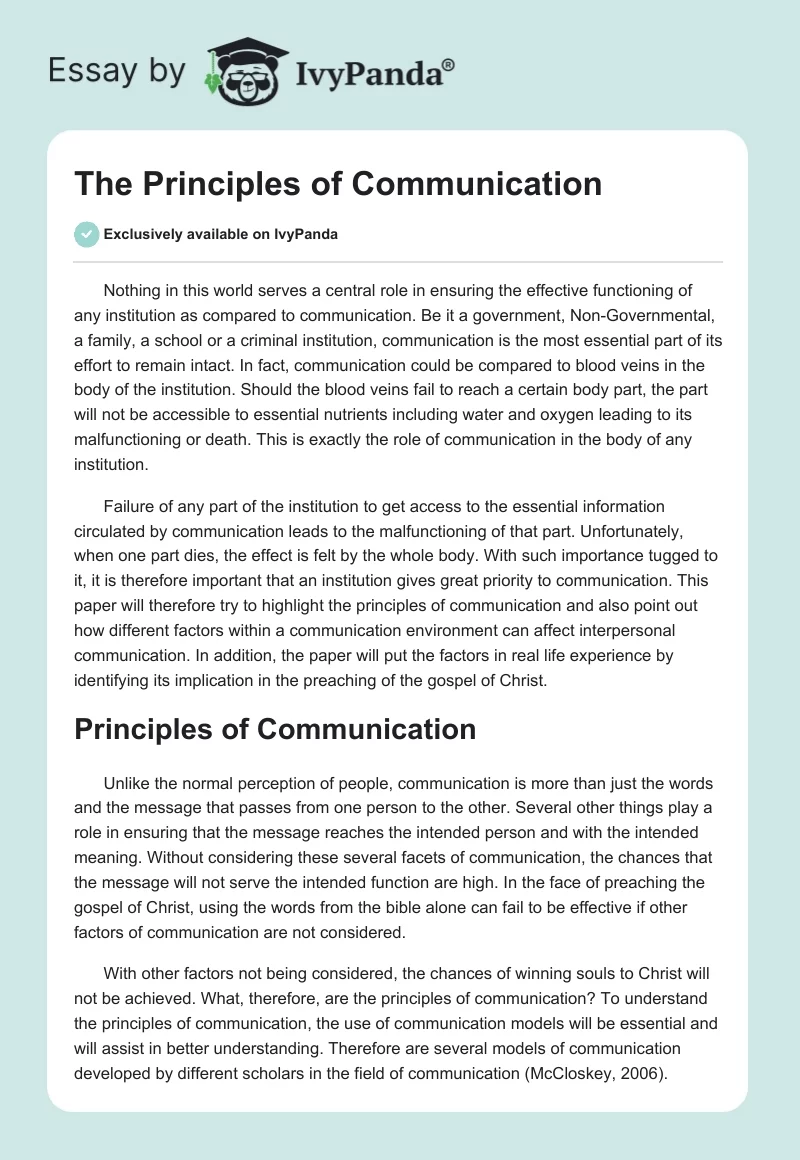Nothing in this world serves a central role in ensuring the effective functioning of any institution as compared to communication. Be it a government, Non-Governmental, a family, a school or a criminal institution, communication is the most essential part of its effort to remain intact. In fact, communication could be compared to blood veins in the body of the institution. Should the blood veins fail to reach a certain body part, the part will not be accessible to essential nutrients including water and oxygen leading to its malfunctioning or death. This is exactly the role of communication in the body of any institution.
Failure of any part of the institution to get access to the essential information circulated by communication leads to the malfunctioning of that part. Unfortunately, when one part dies, the effect is felt by the whole body. With such importance tugged to it, it is therefore important that an institution gives great priority to communication. This paper will therefore try to highlight the principles of communication and also point out how different factors within a communication environment can affect interpersonal communication. In addition, the paper will put the factors in real life experience by identifying its implication in the preaching of the gospel of Christ.
Principles of Communication
Unlike the normal perception of people, communication is more than just the words and the message that passes from one person to the other. Several other things play a role in ensuring that the message reaches the intended person and with the intended meaning. Without considering these several facets of communication, the chances that the message will not serve the intended function are high. In the face of preaching the gospel of Christ, using the words from the bible alone can fail to be effective if other factors of communication are not considered.
With other factors not being considered, the chances of winning souls to Christ will not be achieved. What, therefore, are the principles of communication? To understand the principles of communication, the use of communication models will be essential and will assist in better understanding. Therefore are several models of communication developed by different scholars in the field of communication (McCloskey, 2006).
In this paper, we shall use the Basic Communication Model and the Shannon-Weaver Model. These two models will give us an insight in the principle factors of communication and offer an explanation through which these factors influence communication.


From the models above, several factors can be found to play different but important roles in communication. These are the principles of communication (McCloskey, 2006).
Information Source
This is the person from which the message originates. This person wants a certain message to reach the desired recipient and make him respond in the desired way. In the gospel realm, this involves the pastor or the evangelist who is preaching the word to the nonbelievers. He is transmitting the message with the sole aim of winning their souls to Christ.
Encoding
This is a process carried out by the source. It involves the putting of the message in a coded system before transmitting it to the respondent. In this process, the coded system includes words that could be spoken or written. It can also include other forms of communication systems including gestures and facial expressions. The source should always ensure that the respondent is in a position to understand the coded system used otherwise the communication process will not send the desired message leading to lack of communication. In this stage of communication, the preacher must ensure that his message of Christ is put in such a way that it will be influential to the nonbeliever. The source of the message should package his message in a very appropriate way that will consider the listener and his attitude and assumptions.
The Message
This is the specific content of what the source is transmitting to the respondent. For example, if a preacher is speaking to a congregation, the content of the message will be Jesus Christ and his forgiveness of sin and that he died and was resurrected on the third day.
Noise Source
These are the signals that are unwanted that and which serve as disruptors of the fidelity of the message. Several factors act as sources of noise when it comes to interpersonal communication. These include Cultural noise, which involves the cultural factors that create misconceptions and also create some negative inputs which hamper the understanding of the message. A good example is where the listener perceives the Gospel as a collection of mythical stories and therefore not relevant to his life which is real.
Secondly, there is personal noise which involves personal experiences and personal attitudes that play a negative role in ensuring that a person clearly understands the message. For example, the listener might have had a negative experience with a pastor or some Christians leading him to form a negative attitude towards the religion. This will be an impediment to the communication of the message of Jesus Christ.
Another form of communication may come in terms of theological noise. In this form, the listener might be influenced by some theological beliefs that will make him not perceive the message as it was meant. For example, the source might be preaching on the topic of Baptism. While both the source and the listener will be in line with the importance of baptism, the listener might be thinking in terms of being baptized by jumping a fire or going round a flag while the source was actually meaning being immersed in water. There are several other forms of noise that directly affect the fidelity of the message.
Decoding
This involves the interpretation of the encoded message and having a mental grasp in ways that can be relevant to him. The greatest point to note is that every listener understands the message according to individual assumptions and presuppositions. This means that the meaning of the message is not mainly in the words used but is mainly in the mind of the listener. While an identical message can be transmitted to two people, the reactions might differ due to the different interpretations during the decoding of the message. This means that decoding of the message coupled up with the noises play the greatest role in the distortion of the message.
Therefore, the meaning of a message is simply in the mind of the listener and words act as stimulators of the meaning. A good example can be witnessed in the Baptism example shown above. While the words may carry identical graphical and phonological structures, the meaning differs completely by the source and the listener. While the source will be talking about being baptized in water, the internal meaning of the listener will simply understand that the source will be talking about walking around the flag.
Feedback
This is the best way to identify whether the message has been decoded correctly and has not been drastically interfered by the noise. This is the process where the listener decodes the message of the source and then encodes it before sending a message back to the source showing the degree to which the message has been understood. This process is important because it leads to a dialogue which is vital in engaging the listener.
It also allows the source to identify the degree to which the listener has understood the message and therefore try to improve on his accuracy. Through feedback, the source can identify the needs and assumptions of the listener and therefore make the message relevant to the listener. This stage is important to a preacher of the gospel of Jesus Christ because it is from here that the preacher will be in position to understand whether the message has reached his audience and whether it had an implication in their life.
This would be in terms of seeing them coming to receive Christ. In addition, it is from feedback that a preacher can identify the impediment to effective communication and try to make his message more relevant to the listener. In the example given above, when the listener responds by saying, “Yes, I went around the flag three times during my baptism and therefore I am born again.” The preacher of the word will realize that they are not reading from the same book and therefore make his message relevant by concentrating on the concentrating on the baptism by water and not the flag.
How the Choice of Words Can Influence Attitude, Perception and Behavior
Although the mentioned principles of communication can play a great role in the final result of the message, they don’t form the ultimate environment through which a message works. Words also have a great role in the formation of attitude, perception and behavior (Mortensen, 2006). As the law of verbal communication dictates, “the more skillful a person is in the use of language, the more persuasive they will be.” He goes ahead to argue that the correct use of language can lead one to attain power and even persuade people to buy a certain product or idea. With the appropriate use of words, one can easily make his audience develop a certain thought design, or certain feelings and actions.
In his argument, Mortensen argues that there is no one proper language. Language varies from one setting to the other and also from one event to the other. The power of language does not only dwell in the whole message but even a single word within the whole paragraph can make the difference. For example, in a study, a guest speaker was introduced using two different lists of adjectives which had only a single word differing from the others but the implication was great. The attitude of the students towards the guest varied greatly because of the single word. The two lists contained the following words.
Cold, industrious, critical, practical, and determined
And the second list had
Warm, industrious, critical, practical, and determined
The end result was that those students who read the list containing the word “cold” developed a “cold” attitude towards the speaker as compared to those who read from the “warm” list. This happened despite the similarity between the all the other words. This shows that a single word can have a great impact on the formation of attitude, perception, and behavior of people.
Using the right words can also help one get the desired response from the audience. For example, choosing words like Murder, Hate, cancer, despair, depression, sad when read vocally and in a slow manner make one develop a certain attitude as compared to a passage that contains words like Wealth, Success, inspiration, happiness, joy and health. Reading the two lists of words creates a certain feeling that is completely different from each other. This means that a good speaker who understands how to choose his words can attain a desired response or behavior (Mortensen, 2006).
These uses of words are very evident in the gospel realms. The choice of scary words is greatly used to scare people from Satan. In the contemporary summons, preachers will be heard using hard scary words when defining the world which is also referred as the kingdom of Satan. For example, they could be quoted saying that the world is full of suffering, full of sicknesses and pain. Sorrow and sadness abound in the world and death is the utmost result of sin. These words are rarely used when describing the heavenly Kingdom. Success, happiness, joy, and health are the only adjectives in heaven and in salvation. Christians do not die; they just sleep in Christ waiting to for the Day of Judgment. The word death is not applied to Christians. It is substituted by resting or sleeping in Christ.
Culture and Gender in Interpersonal Communication
Culture also plays an important role in the communication process. There are several concepts that make culture have an impact on interpersonal communication. The way the listener perceives the source of the message will impact greatly on how he interprets the message. Study shows that a person is not born with culture. It is mostly learned through transmission from one generation to the other.
Factors that define culture include country of origin, gender, region, socioeconomic status, age, marital status, sexual orientation and marital and parental status. All the different factors that define the cultural context usually have distinct and specific values, beliefs and norms that are used as guidelines in the process of problem-solving. One of the greatest role players in culture in terms of interpersonal communication is the use of proxemics.
This word which comes from the word “proximity” refers to how different people perceive social and personal space. According to the scholars, there are four different types of personal spaces. We have the intimate space, which is specifically designed for private activities, there is the personal distance which is designed for communication with close friends, and thirdly, there is the social distance which is used for business transactions and finally the public distance which is used in large gatherings and public speeches. These spaces impact greatly on the way a person perceives the message being transmitted. For example, the application of the intimate space is most likely to win confidence and trust as compared to public space (study world, 2006).
Another aspect of culture that affects interpersonal communication is Chronemics. Within this cultural setting, some cultures regard the phenomenon of time as important and of great significance. In other cultures, time is taken as a concept of a circular phenomenon that calls for no pressure for the future.
In such a culture, there is usually no need to create newness as there is still time. In addition, the people raised in such a culture that perceives time as a round phenomenon have a lesser concern towards death as compared to the societies that view time in a linear perspective. Most of the Native Americans and Africans perceive time in this framework. Contrarily, Europeans, Asians and North Americans perceive time in a linear perspective and always perceive lateness as signs of procrastination and irresponsibility (Studyworld, 2009).
In most cultures, it was traditionally believed that men are superior to women. While the view has changed with time with contemporary views dictating for a more equality-oriented approach has been more advocated for (Berry et al, 1997, p 367).
For example, most men would perceive a woman to be less knowledgeable as compared to men. This has a great impact on communication. While women in a higher position would expect their juniors who are male to respond in a given way, the chances are that they would not get the exact desired response because of the perception that the men have for women. In addition, some religious cultures would not permit women to express certain sentiments which are completely believed to be men’s responsibilities. The use of certain words would be referred to as rude if they were used by a woman but very acceptable if used by a man.
What therefore is the importance of such cultural perceptions in the preaching of the gospel of Christ? One important factor is that in some cultures, women would not be accepted to stand before men and teach them. This is evident in most Islamic countries. Using a woman preacher would therefore mean that the nonbelievers will not even want to listen. The preacher of the gospel will therefore be forced to use a male preacher.
The nonbelievers will not be convinced to accept Jesus-which is the main purpose of preaching, if they were taught the word by a woman preacher because they believe that a woman cannot stand before men and teach. In addition, chronemics would play an important role in the audience’s reception of the word of God. When dealing with the people who belong to the culture that views time as a round phenomenon and who are not in hurry with the future, a strategy must be arrived at to ensure that they see the urgency of receiving Christ. This is because they will in most cases feel that they are not in a hurry to receive him.
He could as well come later in life when they are settled or married etc. the proximity by which the preacher maintains with the nonbeliever will contribute greatly in the effort to make him accept Jesus. Maintaining a close personal distance will help in making the nonbeliever develop trust and thus contribute greatly, therefore, leading to a two-sided conversation that offers feedback and thus identification of the needs of the nonbeliever by the person preaching.
This means that for a message to be well understood, the person delivering the message creates the first impact. As an individual, he will contribute to the success or failure of the nonbelievers in accepting the gospel. This is in terms of his gender in relation to the audience. If the culture of the audience perceives gender in a certain perspective, then the speaker will be able to effectively communicate if he falls on the positive side of the listeners’ gender considerations.
The opposite is true. To facilitate the understanding of the message of Jesus, the principles of communication must be considered critically so as to avoid misinterpretations. Furthermore, the cultural aspects of the audience should be considered greatly in order to effectively communicate. Failure to put all these into consideration will always translate to misinterpretations and other failures that would result in zero progress when trying to communicate the gospel of Jesus to nonbelievers.
References
Berry, J., Marshall, S., and Kagitcibasi, C. Eds. (1997). Cross-Cultural Psychology. 2nd ed. New York: John Berry.
McCloskey, M. (2006). An Interpersonal Communication Model. Great Com. Web.
Mortensen, K. (2006). Power Selling with Word Choice. Web.
Studyworld. (2009). Interpersonal Communication in an Intercultural Setting. Web.


